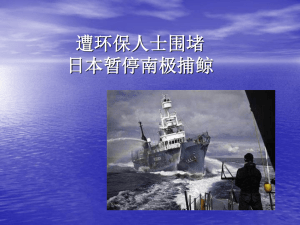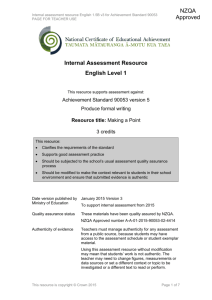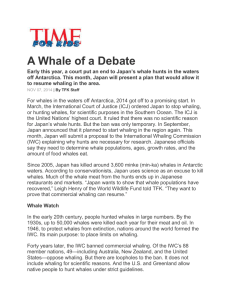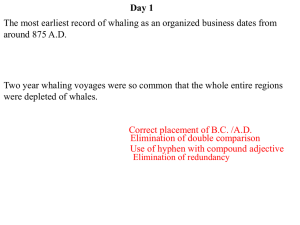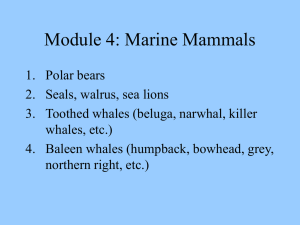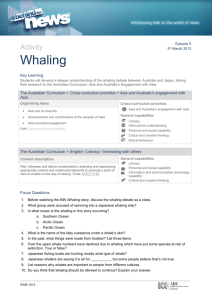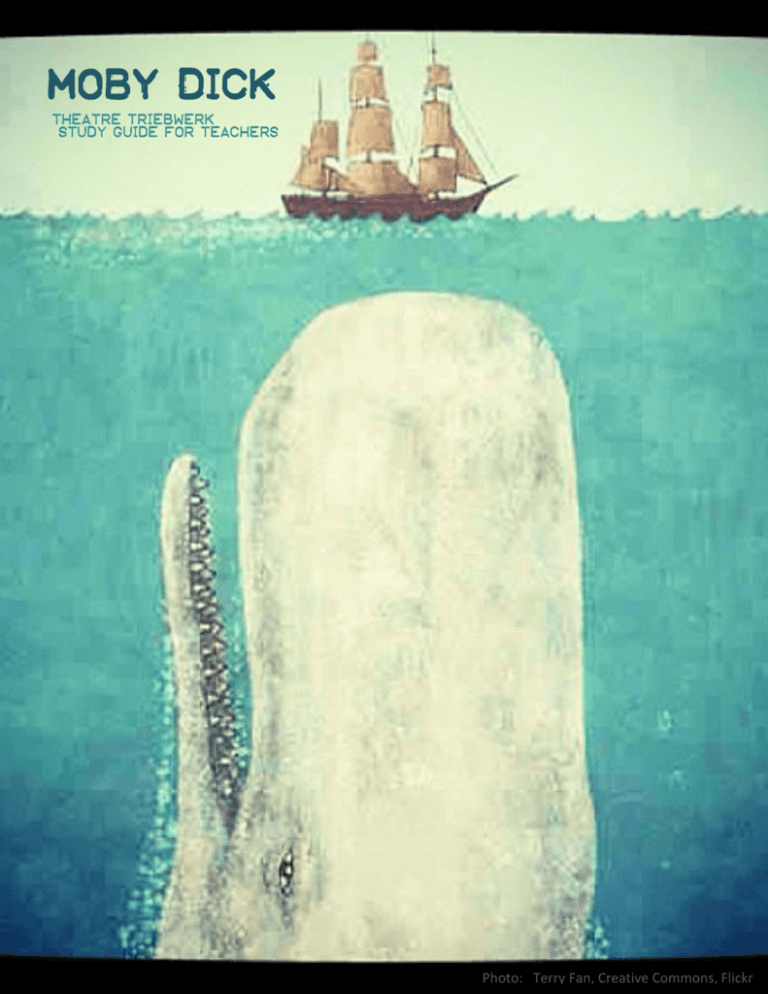
MOBY DICK
Theatre TRIEBWERK
Study Guide for Teachers
Photo: Terry Fan, Creative Commons, Flickr
ABOUT THE STUDY GUIDE
Dear Teachers:
We hope you will find this Study Guide helpful in preparing your students for what they will see and hear at
the Theater Triebwerk performance of Moby Dick. Theater Triebwerk combines music, choreography, and
language to create vivid, exploratory spaces. Using simple props, staging, costume changes and music effects,
Theatre Triebwerk transforms simple stages into violent seas and the claustrophobic atmosphere of the ship –
and the book itself. Throughout the Study Guide you will find topics for discussion, links to resources and
activities to help facilitate discussion of what some consider the greatest American novel.
STUDY GUIDE INDEX
I. ABOUT THE PERFORMANCE
a. Overview
b. The Company
II. ABOUT WHALES
a. Fast Facts About Sperm Whales
b. Can Whales Attack Humans for Revenge?
III. ABOUT WHALING
a. Fast Facts About the History of Whaling in America
b. Products from Whales
c. Life Aboard a Whaling Ship
d. Whaling Today
IV. ABOUT THE NOVEL
a. The Author
b. About Moby Dick
c. What Makes a Great Novel
V. TOPICS FOR DISCUSSION AND ACTIVITIES
VI. OTHER RESOURCES
ABOUT
the performance
OvervieW
Narrated by Ishmael, the lone survivor of Captain Ahab's quest for vengeance
against the forces of nature that have conspired against him, Moby Dick is a
the story of a legendary white whale and a deranged captain's obsessive need
to destroy him. Ahab, captain of the whaling ship the Pequod, on which
Ishmael is a sailor, is single-minded in his desire to hunt the legendary white
whale responsible for crippling him by ripping off his leg. An exciting sea
adventure, Moby Dick is a great reference on whales and the whaling industry
of the mid 19th century. Moby Dick explores the nature of good and evil, fate
and freewill, man verses nature while providing a critique of American class
and racism of the time.
The Company
Did you know?
Moby Dick is based on real
events? Aside from
Melville's own experiences
on the whaling ship
Acushnet, he may have been
inspired by the sinking of a
Nantucket whaling ship
called the Essex in 1820
(allegedly rammed by an
enraged sperm whale) and
an article by Jeremiah N.
Reynolds that appeared in
the Knickerbocker in May of
1839 describing a sea
captain obsessed with
hunting a legendary white
whale.
The Theater Triebwerk was founded in Hamburg Germany, in 1995 and
quickly built a reputation for producing high quality theater for young
audiences. A working collective, Theater Triebwerk was founded on the desire
to make narrative theater more vivid and exploratory. The company prides
itself on using music as a narrator: setting tone, mood, and atmosphere. Using
the simplest and barest of ingredients, and employing minimal props and
costumes, Theatre Triebwerk creates affected spaces and thrills audiences of all ages.
Being in the Audience
When you enter the theater, you enter a magical space, charged, full of energy and anticipation.
Show respect by watching and listening attentively
Do not distract fellow audience members or interrupt the flow of performance
Please applaud at the end of the performance to show enthusiasm and appreciation.
Resources
http://en.wikipedia.org/wiki/Moby-Dick
http://www.theater-triebwerk.de/wordpress/en/triebwerk/
ABOUT WHALES
Fast Facts
About Sperm Whales.
Binominal Name:
Other names:
Animal Type:
Location:
Population:
Size:
Weight:
Depth:
Lifecycle:
Teeth:
Social Unit:
Diet:
Vocalization:
Predators:
Physeter macrocephalus
Leviathans
Mammal
Most of the world's oceans excluding the High Arctic
Considered vulnerable due to whaling
49 to 59 ft (15 to 18 m) with the head represent one-third of it's length.
35 to 45 tons (31.8 to 40.8 metric tons)
Dive up to 3280 ft (1000 m) underwater holding its breath for up to 90 minutes.
Over 70 years
Largest teeth of any whale
Females and young males live in groups of about 6 to 9 whales but can
sometimes live in groups of up to 20
Carnivore, eats hundreds of pounds of squid, octopus, and other fish —about
one ton (907 kg) per day.
Produces loud clicking sounds used to communicate and as a form of
echolocation that whales use to see in the dark and to hunt
Humans, Orca (Killer Whales), and occasionally Sharks
http://commons.wikimedia.org/wiki/File:Sperm_whale_head_anatomy_%28transverse_%2B_sagittal%29.sv
g
Can Whales Attack Humans
for Revenge?
While it has been accepted common knowledge for some time that
whales are intelligent creatures that display reasoning and emotion,
whales are proving to be even more intelligent than previously
thought. Sperm whales have the largest brains on Earth and brains
that are more complex in some ways than human brains. They have an
advanced cerebral cortex (the part of the brain that controls memory,
attention, perceptual awareness, thought, language, and
consciousness) and develop deep social bonds with their social group
often rubbing against their social group and communicating with them
in the late afternoon. Some scientists believe these large brains assist
in complex memory associated with their kin network while others
believe it is linked to their ability to process sound rather than
intelligence.
Research suggests that whales are sentient, self-aware beings and as
such feel emotions such as pain and suffering and perhaps even
feelings of love. As to whether whales are capable of revenge – that is
the subject of this story, and is still up for debate.
Did you know?
Moby Dick may be based on a
specific animal that actually lived.
Whalers called it Mocha Dick. Mocha
survived more than 100 encounters
with whalers between 1810 and the
1830s. “This renowned monster,
who had come off victorious in a
hundred fights with his pursuers,
was an old bull whale, of prodigious
size and strength. From the effect of
age, or more probably from a freak
of nature... a singular consequence
had resulted – he was white as
wool!”
- Reynolds, J.N., "Mocha Dick: or the
White Whale of the Pacific: A Leaf
from a Manuscript Journal," The
Knickerbocker, or New-York Monthly
Magazine. 13.5, May 1839, pp. 377–
392.
Resources
http://us.whales.org/whales-and-dolphins/brain-power
http://en.wikipedia.org/wiki/Cerebral_cortex
http://www.todayifoundout.com/index.php/2011/12/a-real-life-white-whale-that-destroyed-over-20whaling-ships-and-survived-encounters-with-another-80/
About
Whaling
Fast Facts About the History
of Whaling in America.
Native American:
Colonial Shore Whaling:
Deep-Sea Voyages:
Longest Known Voyage:
Departure:
Destinations:
Equipment:
Processing Equipment:
Peek of Whaling:
Decline:
Pacific Northwest tribes, Eastern woodland tribes used whales that washed up
on the shores
1644 – Southampton, Long Island – small boats launched into the surf when
whales sighted offshore
Whales decline off coasts of Cape Cod and Nantucket in the 1720s. Sloops
followed whales west of Greenland. Technological advance allowed for
processing on board. Bigger sturdier ships allow for longer voyages:
Schooner - smallest whaler six months; Brigs, Barks and other large ships
traveled for three to four years.
Ship Nile reportedly whaling for eleven years between the years 1858 to 1869
American Ports such as New Bedford, Massachusetts, and Nantucket
Bigger boats traversed the North and South Atlantic as far as Guinea in Africa,
and the Arctic
Small light whaleboats for the harpooning of whales, plus the technology for
processing, storing, and preserving their catch
Tryworks: two iron pots in a brick furnace that boiled the oil. Oil was stored in
casks below deck.
1814 through to the 1860s
Petroleum discovered in Pennsylvania 1859 and American Civil War (1861-1865)
and Norwegian advances in whaling technology
Did you know?
“Nantucket Sleigh Ride” was the term sailors used for the roller-coaster ride
they experienced after harpooning a whale. It was common for harpooners
to be dragged by the fleeing whale for two or three hours before tiring.
Once the whale tired, it was killed, taken to the ship, cut up and its blubber
boiled down for oil.
Products
th
In the 18 century Sperm whales were prized by whalers for the waxy substance found in their head called
Spermaceti. Spermaceti was refined into spermaceti wax or into sperm oil. Due to the waxy nature of sperm
oil, it was used differently than other whale oils and highly valued. Spermaceti and it's derivatives were used in
cosmetics, leather working, candles, soaps, machine oils, lamp oils, pencils, crayon, leather waterproofing, rust
proofing, and pharmaceutical compounds.
Baleen was also extracted from whales. Sometimes considered the “plastic of the 1800's”, it is a bone-like
substance used in women's corsets, hairbrushes, buggy whips, collar stays and other products.
About one percent of Sperm whales also produced ambergris – a solid, waxy, flammable substance – highly
valued by perfumers for allowing scents to last much longer. Scientists believe ambergris may be produced by
the whale's gastrointestinal tract to ease that passage of hard, sharp object the whale may have eaten such as
the beaks of giant squids. Ambergris can still be found in various perfumes from around the world although
now it is either found at sea or washed up on beaches.
Did you know?
Ancient Egyptians burned ambergris as incense, while in modern Egypt ambergris is used for scenting cigarettes. The
ancient Chinese called the substance "dragon's spittle fragrance". During the Black Death in Europe, people believed
that carrying a ball of ambergris could help prevent them from getting the plague. This substance has also been used
historically as a flavouring for food and is considered an aphrodisiac in some cultures. During the Middle Ages,
Europeans used ambergris as a medication for headaches, colds, epilepsy, and other ailments.
http://en.wikipedia.org/wiki/Ambergris
Resources
http://en.wikipedia.org/wiki/Trywork
http://en.wikipedia.org/wiki/Baleen
http://en.wikipedia.org/wiki/Spermaceti
http://en.wikipedia.org/wiki/Ambergris
https://www.youtube.com/watch?v=1ZKnrHSbkjg
http://www.eyewitnesstohistory.com/whaling.htm
http://www.whalingmuseum.org/learn/research-topics/overview-of-north-american-whaling/life-aboard
Life Aboard
a Whaling Ship
An isolated society
The whaleship was an isolated community that roamed the oceans of the world on journeys that lasted for
years. In Etchings of a Whaling Cruise (New York, 1846), J. Ross Browne describes the crew's quarters called
the forecastle, or, in sailor's parlance, the fo'c'sle:
"The forecastle was black and slimy with filth, very small and
hot as an oven. It was filled with a compound of foul air,
smoke, sea-chests, soap-kegs, greasy pans, tainted meat,"
sea-sick Americans and foreign ruffians. The ruffians were
"smoking, laughing, chattering and cursing the green hands
who were sick. With groans on one side, and yells, oaths,
laughter and smoke on the other, it altogether did not impress
[me] as a very pleasant home for the next year or two. [I was]
indeed, sick and sorry enough, and heartily wish [myself]
home."
- J. Ross Browne 1846
How long is long?
The larger a vessel, the greater distances it could travel. The whaling schooner, the smallest whaler, generally
undertook 6-month voyages, while brigs, barks, and ships might be at sea for three or four years. The longest
whaling voyage is believed to be that of the Ship Nile from 1858 to 1869 – eleven years!
Men on board
The size of the crew depended on the size of the vessel and the number of whaleboats it carried – ranging
from sixteen up to at least 36 on the largest ships. These men were organized in a rigid hierarchy of officers
and crew:
The captain was absolute master of this strange floating world
The officers – three or four mates – were next in rank, each commanding a whaleboat
The boatsteerers were the harpooneers and enjoyed more privileges than the rest of the crew; the
blacksmith, carpenter, cook, cooper (cask maker), and steward also ranked higher than ordinary
crewmen – when the crew chased a whale, these men remained behind as shipkeepers
The foremast hands were the ordinary crewmen
How they were paid
Each man received a "lay" – a percentage of the profits – instead of wages, the size depending upon his status.
The captain earned the largest share, perhaps 1/8th, and the green hand (inexperienced crewman) the least,
as little as 1/350th. An ordinary crewman might earn only $25 for several years work.
Earning less than nothing
The crew might receive nothing on a voyage where profits were low. Even on a profitable trip, a whaleman
might end up in debt to the ship-owners. Cash advances for his family or to spend in ports of call, and any
tobacco, boots, or clothes he purchased from the ship's store were charged against his lay. In debt as they
sailed into home port, many men immediately signed on for another voyage.
Sleeping and eating
Meals and quarters reflected the ship's class structure:
The captain slept in a stateroom and enjoyed a cabin with a sofa and chairs in the stern (rear) of the
ship. He ate the best meals on shipboard. Ducks, pigs, and chickens were often carried in crates to
provide meat for his table;.
The mates had smaller cabins in the stern and ate meals with the captain in the main cabin.
The boatsteerers (harpooneers) and the more skilled members of the crew, such as the blacksmith and
cooper, had bunks in the steerage – an irregular-shaped compartment in the middle of the ship
(midship). They ate in the main cabin after the captain and mates left, usually being served the same
meals, except for butter and sugar. Like ordinary hands, they used molasses to sweeten their coffee or
tea.
The foremast hands – ordinary crewmen – slept in the forecastle, a narrow triangular-shaped room
under the deck in the bow (front) of the ship, in narrow bunks that lined the walls. The only seats were
the men's sea chests. In fair weather, the cook's helper carried tubs of food to the deck and the
crewmen ate there, retreating below deck during foul weather.
An appetite for salt horse
Although the crew's rations ranged from unpleasant to revolting, hard work gave them good appetites, even
for greasy pork, hard biscuits, and cockroach-laden molasses. Other fare included "salt horse" (heavily salted
beef, pork, or horse), beans, rice, or potatoes. The chance to eat something fresh was a treat. At ports of call,
fresh water, fruits, and vegetables were taken aboard. Cooks became used to preparing sea turtles, dolphins,
sea birds, and fish. A ship cruising off the African coast once harpooned and ate a hippopotamus.
Living with accidents, vermin, and punishment
Apart from the dangers of the hunt, life on a whaleship could be unpleasant:
Rats, cockroaches, bedbugs, and fleas were facts of life, perhaps because of the oil and blood that were
not removed from the decks by scrubbing. The men endured these creatures in their food, in their
bunks, and on their bodies - Sharp-edged tools, hostile natives, and shipboard arguments led to
injuries. It was usually the captain who dealt with illnesses, using limited knowledge and supplies from
the medicine chest. Occasionally, a captain's wife on board would nurse ailing crewmen
Punishments included being "put in irons" and flogging (whipping). If a man disobeyed orders or
otherwise displeased captain or mate, he suffered one or the other. The "cat-o'-nine-tails" (a whip of
nine knotted lines) was often used. It was painful for the crewman who experienced it, and frightening
for others to watch.
Boredom on Ship
Being aboard a whaling ship for years on end, with sometimes days and months between whale sightings,
crews often spent their days employed in various duties like washing the deck or changing the number of sails
on the mast. After the work of the day, crews often came on
deck to socialize, read, mend clothes, and later sing and
dance. Holidays and other celebrations were at the whim of
the Captain. The crew would mark the day with singing, firing
guns, and whaleboat races. The captain and officers would
enjoy a special meal with generous captains extending these
festive treats to all hands.
Whalemen would sometimes use these hours to create
homecoming presents for loved ones in the form of
scrimshaw (carvings and engravings usually on bone or ivory
or other left over materials).
Meeting another whaleship on the high seas was cause for
celebration. A “gam” was held where all crew members were
ferried on whaleships between the ships so all crewmen could
exchange news and socialize. Gams could last a day or a week
with the ships eventually parting ways.
Seagoing Wives
Whaling was very much a male occupation, leaving families
separated for years at a time. This changed in 1822, when
Mary Hayden Russel and her young son joined her husband
Captain Joseph Russell under took their first whaling voyage.
Other families followed suit and scholars have
identifiedseveral hundred seagoing wives. Wives washed
clothes, cooked, sewed, educated children, wrote diaries,
tended the sick, calmed their husbands, and occasionally
called out “There she blows!”
Woman in gamming chair being brought onboard from
The movie "Down to the Sea in Ships." #2000.100.62.142
Source: Life on a Whaling Ship: New Bedford Whaling Museum
Resources
http://www.whalingmuseum.org/learn/research-topics/overview-of-north-american-whaling/life-aboard
Whaling
Today
Beginning in the 1860s, the Norwegian sealing captain-entrepreneur Svend Foyn pioneered revolutionary
methods for hunting and processing whales. Instead of the rickety, old fashioned sail- and oar-powered
whaleboats favored by traditional Yankee whalers, Foyn introduced mechanized, steam-powered catcher
boats equipped with bow-chaser deck cannons and heavy-caliber harpoons that exploded on impact. These
increased efficiency and volume, enabling the harvest not only of all of the species that had been hunted for
centuries (notably, Northern and Southern right whales, sperm whales, Arctic bowheads, humpbacks, and gray
whales), but also blue whales and finbacks–the largest species, which, by reason of their speed in the water,
had eluded all previous hunting technologies.
The Norwegians first exploited their own coastal waters. Later, between 1904 and 1940, they established
shore-whaling stations on six continents (including on the American Northwest Coast) and pioneered pelagic
factory-ship expeditions to the vast, hitherto unexploited grounds of Antarctica, employing entire fleets or a
dozen or more vessels for months-long voyages to high South Latitudes. Many technological innovations
followed, including stern slipways on factory-ships for hauling entire carcasses aboard, integrated fleets of
vessels with specialized tasks of catching, towing, processing, and bunkering, spotter aircraft and radio
communications to track migrating whales, and remarkable advances in ordnance, food chemistry, and
processing machinery. Britain, Germany, the Netherlands, China, Korea, Argentina, and Japan followed
Norway into pelagic factory-ship whaling; two factory-ships partly owned in the United States and technically
registered at Wilmington, Delaware (which had also briefly been a conventional whaling port in the 1840s),
were also sent whaling in Antarctica in the 1930s.
It was this relentlessly efficient technology, and the failure of the whaling nations to adhere to protective
quotas regulating the catch, that in the decades following World War II devastated several species to the point
of extinction. International treaties were negotiated in the 1930s to regulate the hunt, and the International
Whaling Commission was established in 1949, with an expert Scientific Committee to monitor population and
abundance. However, lack of enforcement authority, inherent administrative flaws, and persistent
international disputes, combined with clandestine over-fishing and under-reporting of the catch (notably by
the Soviet Union), fatally weakened IWC effectiveness. In 1972 the United Nations called for a cessation of
whaling and the United States Congress passed an Endangered Species Act; whale sanctuaries were declared
in the 1970s and ’80s, and a general moratorium on commercial whaling, adopted by the IWC in 1982, took
effect in 1987–measures intended to protect whales from ultimate annihilation. Nevertheless, some nations
have resumed limited whaling outside the jurisdiction of the IWC (taking species that are not generally
considered to be critically endangered). The condition of several species – the North Atlantic right whale, the
Arctic bowhead, and the Pacific blue whale – remains critical.
– Source: Whaling Today: New Bedford Whaling Museum
Resources
http://www.whalingmuseum.org/learn/research-topics/overview-of-north-american-whaling/whaleshunting#Modern
About
The Novel
the Author
Herman Melville (1819-1891) was one of eight children born to Allan and Maria Gansevoort Melville in New
York City. In 1839, Melville took his first sea voyage as a crewmember of the St Lawrence – a merchant ship
which sailed from New York City to Liverpool. This experience informed Melville's fourth book Redburn: His
First Voyage (1849). In 1841, worked as a crewmember on a whaling ship the Acushnet. He stayed on the
Acushnet for 18 months before deserting ship with a shipmate in the Marquesas Islands. His adventures
aboard the Acushnet and among a Polynesian tribe – the Typees – are described in Melville's first novel
Typee (1846). Melville left the Typees aboard another whaling ship only to desert that ship in Tahiti. Melville
used his time exploring Tahiti and Moorea as inspiration for his novel Omoo (1847).
Melville eventually found his way back to the United States in October 1844. Inspired by his sea adventures,
he became one of the most popular writers of his time. Aside from the popular success of Typee, Omoo, and
Redburn, Melville also wrote Mardi (1849) and White-Jacket (1850). Melville wrote Moby Dick (originally called
The Whale) in 1851 and changed the direction of the book after meeting Nathaniel Hawthorne. The two
became fast friends and Hawthorne inspired Melville to turn The Whale from a lighthearted whaling
adventure into the dark masterpiece it is today. Melville dedicated Moby Dick to Hawthorn – “In token of my
admiration for his genius, this book is inscribed to Nathaniel Hawthorne.”
Moby Dick, however, was a commercial failure. The novel was either ignored or misunderstood by critics and
readers and marked the decline of Melville's popularity. Interestingly, Melville and Hawthorne's friendship
cooled in 1852 after the failure of Moby Dick. Melville made several other writing attempts including short
stories and the novels Israel Potter and The Confidence-Man (1856) but with little success. Melville gave up
writing after The Confidence-Man and worked as a customs inspector.
After his death in 1891, the manuscript Billy Bud Sailor was published in 1924 spurring a revived interest in his
work. Melville was finally recognized for his literary genius in the 1940s.
THE BOOK
"Herman Melville's MOBY-DICK (1851) is ranked as America's greatest epic. It can
be read as an allegory of the risks in trying to subjugate nature to the will of
humanity, a rebellion against the evil and chaos in the universe, and/or a
metaphor for the narrator Ishmael's search for the meaning of life. Moby-Dick,
the white whale, is usually interpreted as a symbol of evil, God, or an indifferent
universe.
In its complex examination of right and wrong (what Melville calls "Providence,
Foreknowledge, Will, and Fate"), the novel dares to question not only the nature
of humanity but also the nature of God. Ahab, the central figure, is a madman,
but the model of the romantic rebel, hurling his defiance into the teeth of a vast
and inscrutable universe. The novel explores other enduring American leitmotifs
and themes as well.
For instance, despite Ishmael's extensive efforts and exhaustive description, he
can never fully understand the nature of the behemoth Moby-Dick, suggesting
the allegorical limits of human knowledge: efforts to understand God are
inevitably fruitless and may even be fatal, as is the case here. This reading is
reinforced by Melville's inversion of the customary representation of whiteness.
Traditionally a symbol of purity, whiteness in the novel comes to represent a lack
of meaning and even a terrible, evil void. The novel also explores 19th-century
America's belief in manifest destiny and the inevitable exploitation that followed,
shown here in the whaling trade, which echoes the despoiling of the American
frontier through overhunting of the buffalo and the displacement of Native
Americans. “
– PBS: The American Novel
What makes
a Great Novel?
For a novel to be considered a Great American Novel it must capture the spirit, both in social context and
writing style, of the time period the book is meant to represent. Furthermore, it must capture the essence and
uniqueness of the American experience. Authors and books referred to as Great American Novel:
19th century
1851 Herman Melville's Moby-Dick
1884 Mark Twain's Adventures of Huckleberry Finn
20th century
1925 F. Scott Fitzgerald's The Great Gatsby
1929 William Faulkner's The Sound and the Fury
1932 William Faulkner's Light in August
1936 William Faulkner's Absalom, Absalom!
1936 Margaret Mitchell's Gone With the Wind
1938 John Dos Passos's U.S.A. trilogy
1939 John Steinbeck's The Grapes of Wrath
1952 Ralph Ellison's Invisible Man
1953 Saul Bellow's The Adventures of Augie March
1955 Vladimir Nabokov's Lolita
1960 Harper Lee's To Kill a Mockingbird
1960 John Updike's Rabbit, Run and sequels
1973 Thomas Pynchon's Gravity's Rainbow
1975 William Gaddis's J R
1985 Cormac McCarthy's Blood Meridian or the Evening Redness in the West
1985 Larry McMurtry's Lonesome Dove
1987 Toni Morrison's Beloved
1996 David Foster Wallace's Infinite Jest
1997 Thomas Pynchon's Mason & Dixon
1997 Philip Roth's American Pastoral
1997 Don Delillo's Underworld
21st Century
2000 Michael Chabon's The Amazing Adventures of Kavalier and Clay
2010 Jonathan Franzen's Freedom
Resources
http://www.egs.edu/library/nathaniel-hawthorne/biography/
http://www.melville.org/hawthrne.htm
http://www.pbs.org/wnet/americannovel/timeline/mobydick.html
http://www.pbs.org/wnet/americannovel/
TOPICS FOR DISCUSSION
AND ACTIVITIES
You may want to share the previous parts of this study guide with older students to provide context to the
performance and facilitate discussion. Be prepared to share your own expectations of and reflections about
the performance. Have students compare ideas and ask questions to make new discoveries. We have provided
you with just a few suggestions of topics for discussion and activities to help your students learn more about
the novel, the author, whaling, and man’s (sometimes difficult) relationship with nature.
1. The Triebwerk Experience
Discussion: Have students ever seen a play done like this before (minimalist, musicians as actors)? Did they
like the style (why or why not)? What was their most favorite moment? What was their least favorite
moment? What is minimalism? How did the style of the performance contribute to the story?
[Theatre Triebwerk] Productions so far were aimed at children as well as young
people and adults. All those productions are linked through their focus on the use of
live music on stage as a theatrical element, the interest in making narrative theatre
more vivid and exploratory space for improvisation in which elements of linguistic,
musical and choreographic nature can be found.
- Theatre Triebwerk Website
Activity: Be the critic – write an article (5-7 paragraphs) aimed at publication in a school or local newspaper or
blog describing the performance. Rather than focusing on the content of the performance, focus on the way
the play was staged, the use of live musicians and the minimalist style. Try not to make value judgments (“I
liked it.” or “I didn’t like it.”) but rather to describe the way the artists used their own artistic style to tell the
story and to create a mood.
Resources
http://www.theater-triebwerk.de/wordpress/en/
http://en.wikipedia.org/wiki/Minimalism
http://www.theguardian.com/stage/theatreblog/2011/feb/09/set-design-theatre-stage
2. What Makes a Novel “Great”?
Discussion: What defines a great work of literature? Is it commercial success or something else? Do great
works of literature appeal to almost everyone, or are some great novels culturally specific? Why do we read
the classics?
Perhaps the most eloquent consideration of this question is Italo Calvino’s essay,
“Why Read the Classics?,” in which he defines a classic as “a book that has never
finished saying what it has to say,” among a list of other qualities. But as wondrous
as that sounds, it could also describe some books we read today – “Infinite Jest,” for
example – books that most of our contemporaries would deem too recent for classic
status. I also love Calvino’s effort to capture the imaginative quality of a great
literary work – “a book that takes the form of an equivalent to the universe, on a
level with the ancient talismans” – but suspect that the following is more accurate:
“The classics are the books that come down to us bearing upon them the traces of
readings previous to ours, and bringing in their wake the traces they themselves
have left on the culture or cultures they have passed through.”
- Laura Miller, Salon Magazine
Activity: Have your students write a small essay about – or be prepared to discuss – why one of their favorite
books should be considered a great novel or work of classic literature.
Resources
http://www.salon.com/2014/01/30/what_makes_a_book_a_classic/
http://blogs.publishersweekly.com/blogs/shelftalker/?p=12383
https://www.goodreads.com/topic/show/282005-what-makes-a-book-a-classic
3. Captain’s Log
Activity: Have students write and research their own captain's log. Imagining they the captain of a whaling
ship. They should consider:
Information about the port of departure
Descriptions of the people who signed on for the expedition
Information about where the ship will travel and why
Information about how the crew spends its day waiting for whale sightings
Alternately, students can imagine they are marine biologists, naturalists or photographers instead of wailers.
4. Exploring Cetaceans and Culture
Discussion: What do students know about cetaceans (whales, dolphins and porpoises)? What do they think
about the idea of hunting whales? Is it acceptable to kill animals for food and resources? If not whales, why
chickens? What products were produced from whales? Did commercial whale products make whaling
justifiable? Are their other cultures that value whales (and other animals) differently?
Activity: Write a short essay about a product of the whaling industry. Suggest alternatives that wouldn’t
involve hunting and killing whales. Alternatively, write a short essay or break into teams to engage in a
controlled debate about whether people have the right to hunt and kill other animals on this planet.
Resources
http://iwc.int/aboriginal
http://science.howstuffworks.com/environmental/conservation/issues/whaling1.htm
http://history1800s.about.com/od/whaling/f/whaleproducts01.htm
5. A Day in the Life: A Letter from the Past
Discussion: How has daily life changed since the 18th-19th century? What industries were prominent? What did
people do for work? What did people do with their free time? How have gender roles and racial tensions
changed?
Activity: Have students write a letter to themselves – from the past! “Imagine you are your own distant
relative, living in the 18th-19th centuries. Where do you live? What do you do for work? What are the working
conditions? How do you spend your free time?” This is a great opportunity to discuss how gender roles have
changed, and how society in general has changed. You might also task students with the option to write
themselves a word of caution or warning from the past, for example: “In the future you should do a better job
than we are doing right now taking care of the planet, including the animals. We’ve nearly killed all the
whales, and it would be a shame if your grandchildren don’t ever to get to see one of these majestic creatures
alive.”
Other
Resources.
Grade 4 - 8
Whaling
Black Hands, White Sails (Coretta Scot King, Scholastic Press, 1999)
Revenge of the Whale: The True Story of the Whaleship Essex( Nathaniel Philbrick, Puffin, 2004)
Gone A-Whaling: The Lure of the Sea and the Hunt for the Great Whale (Jim Murphy, Clarion Books,
2004)
Whale Port (Mark and Gerald Foster, HMH Books for Young Readers, 2007)
Whales in American History (Norman D. Graubart, Powerkids Pr, 2014)
Canadian Flyer Adventures #8, A Whale Tale (Frieda Wishinsky, Owlkids Books, 2008)
Thar She Blows: American Whaling in the Nineteenth Century (Stephen Currie, Lerner Publishing
Group, 2001)
Whale Ships and Whaling: A Pictorial History (George Francis Dow, Dover Publications, 2012)
Grade 9-12
Whales & Whaling
• Petticoat Whalers: Whaling Wives at Sea, 1820-1920 (Joan Druett, UPNE, 2001)
• In the Heart of the Sea: The Tragedy of the Whaleship Essex (Nathaniel Phillbrick, Penguin Book, 2001)
• Away Off Shore: Nantucket Island and Its People, 1602-1890 (Nathaniel Phillbrick, Penguin, 2011)
• Leviathan: The History of Whaling in America (Eric Jay Dolin, W.W. Norton & Company, 2008)
• The Yankee Whaler (Clifford W. Ashley, Dover Publications, 2014)
• The Whaler (Steve Roach, 2011)
• Harpoon: Into the Heart of Whaling (Andrew Darby, Da Capo Press, 2009)
Websites
http://www.powermobydick.com
http://teachersites.schoolworld.com/webpages/GHurst/files/whaling%20history.pdf
http://www.pitara.com/science-for-kids/planet-earth-for-kids/the-whale-hunt-is-on/
http://www.girlonawhaleship.org/jernapp/laura.do
https://www.institutofranklin.net/sites/default/files/fckeditor/CS%20Whaling%20in%20New%20England.pdf
Interactive map of
places mentioned
in Moby Dick!
http://mobymap.org/
Diagram of the Pequod
http://www.powermobydick.com/images/PequodCutaway.jpg
Diagram of an Actual Whaling Bark
http://mysite.du.edu/~ttyler/ploughboy/whalingbarktop.htm
Written and designed by Jason Helbig and Joanna Kapusta
© Inside-Out Communications, Toronto. All other rights reserved.

